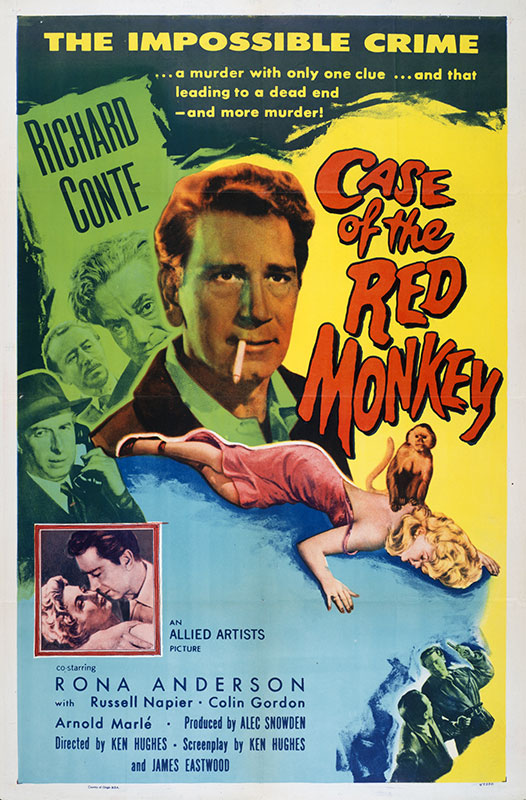
by ASH KINNEY D’HARCOURT
The 1950s ushered in a new era of socio-cultural transformation in the United States in which many families were drawn out of cities and into newly developed suburban communities. This shift was accompanied by an increased emphasis on the nuclear family and the reinforcement of rigid gender roles within American culture. At the same time, the film industry was in search of new markets and pursuing new creative directions as a result of its latest competitor—the television. This led to the proliferation of exciting science fiction films, psychological trillers, spy films and proto-Bond heroes that capitalized on the perceived threat of communism and nuclear destruction at the time.
Revolving around the assassination of nuclear scientists and an American agent, the British nuclear mystery thriller Little Red Monkey (1955) combines these to great effect. The film, which curiously involves the presence of a small monkey at the scene of the murders, achieved international success. An American review of the film at the time of its release remarks on its slow pacing relative to Hollywood fare, but the poster circulated through the Interstate Theater marketed the film as a thriller, adopting the phrase “Case of…” to the title, adding a sense of intrigue and mystery to the movie.
The 1950s ushered in a new era of socio-cultural transformation in the United States in which many families were drawn out of cities and into newly developed suburban communities. At the same time, the film industry was in search of new markets and pursuing new creative directions.
In cases where foreign-language films were distributed in the United States during the 1950s, sexual themes might be exploited in their promotion. French cinema, in particular, was associated with a unique blend of sophistication and allure, exemplified by the promotional poster for the US release of That Naughty Girl (1956) featuring Brigitte Bardot in sultry full-body and profile portraits. The poster boasts a review from the New York Daily Mirror about the film: “The most exciting French offering since champagne and crepe suzettes!” This promotional approach deviated somewhat from the film’s content; despite receiving a “B” rating from the Legion of Decency for being “morally objectionable,” the film itself was a rather innocent romantic comedy and a musical to boot.
Another development during the 1950s was the emergence of a new consumer demographic: the teenager. The film industry was keen to exploit this growing market with disposable income and tailored films to their unique tastes and preferences that included drama, juvenile rebellion, and “hot rod” films that resonated with the consumer culture of the era. These thematic trends are evident in the promotional poster for Teenage Thunder (1957)—a B-movie derivative of the iconic Rebel Without a Cause (1955) but with a distinctly happy resolution for its teenage characters. The movie poster’s visual design employs fiery red and yellow hues, despite the film itself having been recorded in black and white. The top half cleverly uses negative space to emphasize the film’s theme of thrill-seeking “chicken” games and features the tail end of a red car racing off the edge of the poster.
Alfred Hitchcock’s North by Northwest (1959) marks another significant entry in the spy thriller genre. The film’s poster signals a notable shift in design principles, particularly in the realm of big-budget Hollywood A-movies, where more concise typography allowed for greater prominence of other visual elements. This transformation is epitomized in the poster design by graphic designer Saul Bass; the poster embodies the essential elements of the film’s narrative through a simple, yet bold, visual composition. A tilted image of the film’s protagonist amid abstract blocks with a high-contrast red, black, and white color palette creates the impression of the character falling out of the poster and toward the viewer. The design conveys a sense of chaos and dramatic tension, which are central to the film’s story of mistaken identity and deadly espionage. In addition to the poster design for North by Northwest, Bass contributed the kinetic title sequence at the beginning of the film that reflected a new coordinated approach to visual design in film marketing. These developments laid the foundation for the more modern and minimalist style that came to characterize movie poster art in the 1960s, a subject that will be explored further in the next blog entry.
